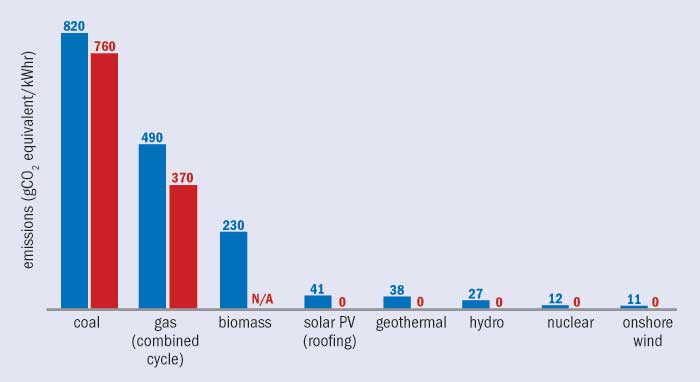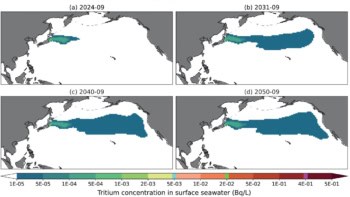Policy and technology expert Gail H Marcus assesses the industry’s environmental credentials in comparison to fossil fuels and renewable energy sources

The environment is a shared resource, and in recent years the question of how to moderate the impacts of human activity on the air, water and land has become increasingly important. One of the characteristics that has received the most attention in this effort is the “greenness” of our energy supply. Yet the term “green” seems not to be well understood and it is not consistently applied. Some sources define a “green” energy source as one with a low environmental impact, but that merely shifts the question towards defining impact. There is currently a lot of focus on greenhouse gases (GHGs), and many definitions seem to view “low impact” and “low-GHG emissions” as synonymous. Alternative definitions, however, include other types of environmental effects, such as particulate air pollution, use of water or the generation of waste products.
This confusion and multiplicity of definitions has particular implications for considering what the term “green” might mean for the nuclear-energy industry. Nuclear power is sometimes characterized as producing no GHGs, and while this is not completely true, it is certainly accurate to say that GHG emissions from nuclear power generation are much lower than those of fossil-fuel-based power sources.
Another characteristic of interest is the sustainability of different energy sources – that is, whether the supply could be “used up” over time. Simplistically, it would appear that both fossil fuels and uranium for nuclear power, being mined from the ground, are finite and will eventually be used up, while “renewable” resources such as wind and sunlight are effectively infinite. However, this viewpoint ignores the fact that the systems required to extract energy from sunlight and wind use mined materials as well.
Likewise, some consider the fact that nuclear power produces long-lived waste as proof that it is not “green”, yet a similar argument could be applied to the wastes generated in producing the components required for solar or wind power generation. All of these arguments – plus others relating to as-yet-untapped possibilities, such as reprocessing used nuclear fuel to extract more energy from it; using a thorium fuel cycle instead of (or in addition to) uranium; or even extracting uranium from unconventional resources, such as sea water – must be taken into account when deciding whether nuclear energy counts as “green”.
Cradle to grave
Unlike fossil fuels, which are all carbon-based and thus produce carbon dioxide when burned, “burning” uranium fuel produces no GHGs. However, other parts of the nuclear fuel cycle, including mining, extraction and enrichment of uranium, do produce some GHGs. This fact has been recognized in many analyses. What is less well recognized is that generating power from wind and sunlight also produces some GHGs.

This needs to be considered in any analysis of “greenness”, but often, it is not. The US Environmental Protection Agency (EPA) is one of many organizations to make this mistake. The EPA definition of green power is “electricity produced from solar, wind, geothermal, biogas, eligible biomass and low-impact small hydroelectric sources”. Thus, on their website it says that, “Although nuclear power generation emits no greenhouse gases during power generation, it does require mining, extraction and long-term radioactive waste storage.”
The EPA does not make a similar statement for solar or wind power. Yet, although solar and wind power – like nuclear power – emit no greenhouse gases during power operation, they also require raw materials to be mined, extracted and processed. In fact, because of the diffuse nature of wind and solar energy, more materials are required to construct and manufacture the structures and components for power production, per unit of energy generated, than are required for other energy sources. In addition, wind turbines use rare-earth metals, which are in limited supply, and the manufacture of solar photovoltaics involves the use of highly toxic materials.
Instead of simply identifying specific energy systems as “green” or “not green”, a better way to assess the “greenness” of energy sources is to examine the full set of environmental impacts from “cradle to grave”. This life-cycle assessment gives a more accurate idea of the total GHGs from any source. It makes it clear that all energy sources generate some GHGs, although the parts of the fuel cycle responsible for the emissions are different for each energy source (see “Start to finish”, above).
Another issue that must be addressed in evaluating GHG emissions is that different researchers have computed different levels of emissions. In 2013 the US National Renewable Energy Laboratory (NREL) reviewed a large number of studies and determined that the variation can be attributed to such factors as differences in the exact choice of designs assumed for each study, different operating assumptions and different evaluation methods. Despite these variations, however, all evaluations of the total life-cycle emissions show coal having significantly greater emissions than any other energy source (see “Measuring up”, above). Natural gas is the best of the fossil fuels in this respect, but it still produces significant emissions. Solar, wind, geothermal, hydro and nuclear power all generate only a small fraction of the GHGs of the larger emitters, with nuclear power usually ranking among the lowest emitters. Hence, if the measure of greenness is based on the emissions over the whole life cycle, nuclear power should be categorized as being similar to wind and solar power.
Waste not
In terms of non-GHG impacts, nuclear power and the renewable energy sources do not generate the particulates that are associated with coal burning, nor do they generate some of the other emissions associated with fossil fuels, such as methane, sulphur or nitrous oxides, organic compounds or toxic heavy metals. The nuclear-energy industry does, however, produce nuclear waste that must be sequestered for thousands of years before the radioactivity decays. The industry is often criticized for this, and its “green” credentials questioned on this basis. However, the volumes involved are small and waste repositories are being developed to ensure that the waste remains sequestered from the environment.
It is also worth noting that other energy sources are not waste-free. Coal produces large volumes of solid waste, in addition to the airborne emissions, but even renewable-energy sources produce waste. Frequently, the toxicity of this waste is an issue, but in some cases even the sheer volume of waste creates challenges. For example, solar energy requires large arrays of solar panels, which degrade over time and must be replaced. For a small country such as Japan, the question of what to do with all these spent panels is already becoming a problem.

The environmental impacts of mining are often mentioned as a consequence of using fossil or nuclear fuels. However, the volume of the resource needed for nuclear power operations is much less than that needed to burn fossil fuels, and this translates to a lower level of environmental impacts from extraction. Moreover, as already noted, renewable energy sources require the mining of large volumes of structural materials, as well as the mining of toxic materials. Although the environmental impacts are a lot smaller than for coal, there are some measurable impacts associated with these mining operations.
A detailed assessment of other types of environmental impact is beyond the scope of this article. A full comparison of energy sources would include such factors as land use, which is greater for solar power and wind than for other sources (although some solar and wind sites can be used for other purposes, such as agriculture in the case of wind farms); impacts on birds and bats (a concern for wind farms); accidents (serious accidents at nuclear power plants can contaminate surrounding areas); earthquakes (from hydroelectric dams and fracking for oil and gas); and impacts associated with disposing of wastes from the various energy sources (building and operating disposal facilities, transporting wastes, and so on).
No free lunch The real truth is that no energy source is completely green. Perhaps it is more accurate to say that there are shades of green. By that measure, nuclear power is very close to the same shade of green as that of most renewables.
But evaluating energy supply options is an incredibly complex and multi-faceted exercise, and while greenness is important, it must be viewed in the context of other considerations. Decision-makers must weigh the GHG and other emissions from each energy source against such measures as cost; short- and long-term resource availability; the reliability of the overall energy supply 24 hours a day; and the security of the energy supply against interruptions by weather or by foreign suppliers.
These evaluations are not static. Resource discoveries and actions by foreign governments can affect supply, while technology developments and government decisions can affect a host of measures, including costs, availability, emissions and other measures. This article has considered only current energy-supply technologies, but a breakthrough in some areas could alter the comparative data significantly. One example of such a breakthrough would be “clean coal” technology – that is, some way of extracting the GHGs from coal emissions before they are released to the environment, and sequestering them from the environment permanently and reliably. Since this type of development can’t be counted on at the current time, it is not considered in the comparative data used in this article. If it later proves to be technically feasible and economic, it could alter the discussion radically. So, too, could the development of fusion energy, or cheap energy storage for renewables.
At present, though, no single energy source excels in all measures. Each has some pros and cons, and most rational national policies seek to diversify their energy portfolios in order to take advantage of the benefits different energy-supply technologies offer and to ameliorate any disadvantages. Although nuclear power has some challenges – notably waste disposal – it appears to be one of the most attractive sources in terms of a small environmental footprint, reliable energy generation, security of the energy supply, and other important measures. Hence, the short answer to the question raised in this article’s title is that nuclear energy is indeed green, and it offers several other advantages as well. It should, therefore, be considered in this light in decision-making on future energy-supply options.



